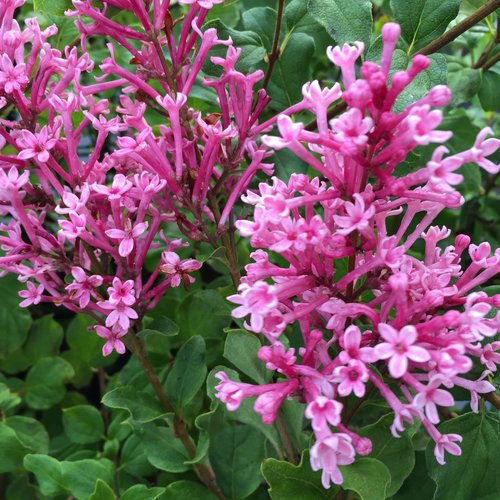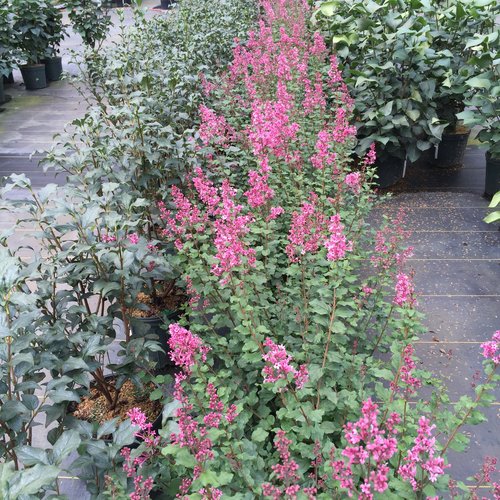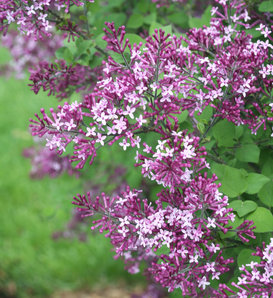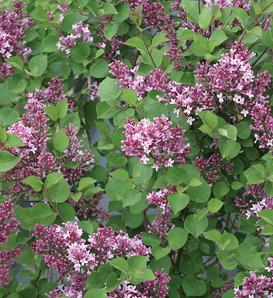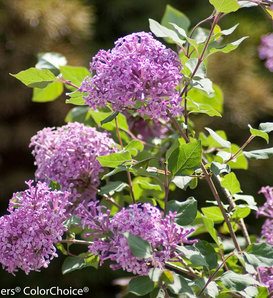I got the lilacs the end of 2019 so put them in a planter box for this summer, they have a very nice scent. They didnt do well because of the chipmunks and squirrels, so i put a fence around the planter. Im keeping them inside another winter with a light and theyre looking much healthier. I'll plant them outside next spring, So we'll see.....
Bloomerang® Dwarf Pink Reblooming Lilac Syringa x
- Sun
- Spring
- Summer
- Fall
-
Details
30 - 36 Inches30 - 36 Inches30 - 36 Inches76cm - 91cm76cm - 91cm76cm - 91cmFeatures
Everything you want in a lilac, but pink - and reblooming!
Think you don't have room for a lilac? Think again! Bloomerang® Dwarf Pink lilac naturally grows as a small, rounded shrub, at just about a third the size of conventional lilacs. It outperforms other lilacs with its pure pink blooms that cover the plant in late spring, then reappear throughout summer and fall. Plus, it's vigorous and resistant to disease. Just plant it in full sun, soil that's not too wet, and enjoy the show for years to come. Available in better garden centers in spring 2019.
Top reasons to grow Bloomerang® Dwarf Pink lilac:
- Dwarf habit takes up just a fraction of the space of other lilacs.
- Fragrant pink flowers for months every year.
- Rarely bothered by deer or disease.
Continuous Bloom or RebloomerAttracts:ButterfliesResists:DeerSmall or MiniatureCharacteristics
Plant Type:ShrubShrub Type:DeciduousHeight Category:ShortGarden Height:30 - 36 Inches 76cm - 91cmSpacing:30 - 36 Inches 76cm - 91cmSpread:30 - 36 Inches 76cm - 91cmFlower Colors:PinkFlower Shade:PinkFoliage Colors:GreenFoliage Shade:GreenHabit:UprightContainer Role:FillerPlant Needs
Light Requirement:SunThe optimum amount of sun or shade each plant needs to thrive: Full Sun (6+ hours), Part Sun (4-6 hours), Full Shade (up to 4 hours).
Maintenance Category:EasyBlooms On:New WoodBlooms On:Old WoodBloom Time:Summer through FallBloom Time:Late SpringHardiness Zones:3a, 3b, 4a, 4b, 5a, 5b, 6a, 6b, 7a, 7bWater Category:AverageNeeds Good DrainageSoil Fertility Requirement:Average SoilSoil PH Category:Alkaline SoilUses:Border PlantUses:ContainerUses:Cut FlowerUses:Edging PlantUses:Good for ScreeningUses:LandscapeUses:Mass PlantingUses:Specimen or Focal PointUses Notes:A dwarf lilac like Bloomerang Dwarf Pink offers a lot of versatility in the landscape. Plant it lining a walkway, under windows, as a low hedge, or anywhere you want color and fragrance with minimal care.
Maintenance Notes:Plant only in full sun and well-drained soil; lilacs cannot tolerate soggy, wet conditions.
The rebloom of Bloomerang lilac occurs on the new growth the plant creates after its spring bloom. For the best rebloom, it's vital that the plant grows vigorously during late spring and early summer. Do this by keeping it well-watered and mulched and in plenty of sun (six hours a day at least). If you wish to fertilize it, you may do so in early spring, once the ground has thawed, and again in late spring, after it blooms.
If you want to prune Bloomerang lilac, do so immediately after its spring bloom. Never cut it back in fall, winter, or early spring - doing so will remove the spring flower buds. It is not necessary to prune Bloomerang lilac in order for it to rebloom. However, giving it a light trim after blooming does remove the developing seed heads (they look like green bananas, and some people don't care for the way they look on the plant), providing a neater look, and encourages more new growth for reblooming. Trimming after blooming will delay the rebloom by a few weeks compared to an untrimmed Bloomerang lilac.
Like nearly all lilacs, Bloomerang lilac actually requires a period of cold weather in order to bloom well. This is why lilacs are not typically suited to warmer climates. However, they are very, very cold tolerant and thrive in climates as cold as USDA zone 3.
Fun Facts:The botanical name of lilac, Syringa (suh-RIN-gah), is from the Greek word syrinx, which means tube. This is because the stems of lilac contain a spongy pith which can be remove, leaving a hollow tube that has traditionally been used to create pan-pipes.
Bloomerang® Dwarf Pink Syringa x 'SMNJRPI' USPP 29,802, Can 6,773 -
3 Reviews
5241321Browse reviews from people who have grown this plant.-
Leslie Coker, Illinois, United States, 3 years ago
-
Planted this in July and this shrub bloomed twice for me over the summer but there were definitely fewer blooms the 2nd time around. It was its first year in the ground last year so I will wait and see how it does for a full season. The blooms are a really pretty bright pink colour and I love the compact nature of this plant.
Farah, Ontario, Canada, 4 years ago
3 More colors
-



